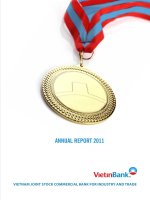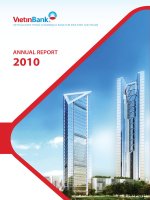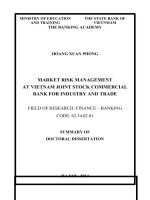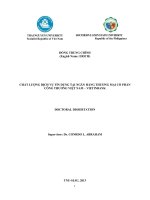Improving credit quality at vietnam joint stock commercial bank for industry and trade thu duc branch
Bạn đang xem bản rút gọn của tài liệu. Xem và tải ngay bản đầy đủ của tài liệu tại đây (739.4 KB, 89 trang )
MINISTRY OF EDUCATION AND TRAINING
THE STATE BANK OF VIET NAM
BANKING UNIVERSITY OF HO CHI MINH CITY
--------------------------------------
CU NGO HAI YEN
IMPROVING CREDIT QUALITY AT VIETNAM
JOINT STOCK COMMERCIAL BANK FOR
INDUSTRY AND TRADE –THU DUC BRANCH
GRADUATION THESIS
MAJOR FINANCE AND BANKING
ID: 7340201
HO CHI MINH CITY, 2018
MINISTRY OF EDUCATION AND TRAINING
THE STATE BANK OF VIET NAM
BANKING UNIVERSITY OF HO CHI MINH CITY
--------------------------------------
CU NGO HAI YEN
IMPROVING CREDIT QUALITY AT VIETNAM
JOINT STOCK COMMERCIAL BANK FOR
INDUSTRY AND TRADE –THU DUC BRANCH
GRADUATION THESIS
MAJOR FINANCE AND BANKING
ID: 7340201
SUPERVISOR
PHD LE DINH HAC
HO CHI MINH CITY, 2018
ABSTRACT
The graduation thesis with the topic "Improving credit quality at Vietnam
Joint Stock Commercial Bank for Industry and Trade - Thu Duc Branch"
presented the general theories on bank credit and raised the characteristics and roles
credit quality, credit quality, and indicators to measure credit quality. From these
basis, the author collects data related to the assessment criteria, comments on credit
activities and quality of credit products of the Branch. Then, draw the results and
limitations of credit quality at the Branch. According to the research results,
VietinBank Thu Duc has a high growth rate of credit outstanding balance, overdue
debt ratio and bad debt ratio are always at low levels. In addition, according to the
survey from customers, the problem that customers are not satisfied in the business
is the cumbersome precedures, the transaction processing time is not fast, the time
to solve loans are still slow, credit products are not very diversified, marketing
policies are not focused. The above mentioned issues are formed partly from banks
and partly from policy, economic situation and customers' activities. Based on the
analytical reasons, the author proposed solutions to overcome, and made
recommendations to the Government, State Bank of Viet Nam and Vietinbank.
COMMITMENT
This is the author's own research, the results in the reaserch are true, without
prior publication of content or other content that is performed by others except for
the references which are cited full source in the thesis.
Author
CÙ NGÔ HẢI YẾN
ACKNOWLEDGEMENT
After four years studying at the Banking University of Ho Chi Minh City, I
have gained a wealth of knowledge and experience from talented, dedicated and
enthusiastic teachers, especially excellent care for students from the Faculty of
Finance - Banking.
Hereby, I would like to send my sincere thanks to all the teachers of Banking
University in Ho Chi Minh City in general and the Faculty of Finance and Banking
in particular,who have created a good environment for me. In particular, I would
like to thank PhD. Le Dinh Hac for giving useful tips, knowledge to help me
complete the graduation thesis.
During the course of the graduation thesis, this can not avoide restriction due
to the shortcomings of experience and limited knowledge. I am looking forward to
receive comments from the teachers, so I can complete the thesis with better quality
and accumulate more knowledge and experience for later work.
TABLE OF CONTENTS
TABLE OF CONTENTS
LIST OF ABBREVIATIONS
LIST OF TABLES
INTRODUCTION
CHAPTER1: THEORY OF CREDIT AND BANK CREDIT QUALITY ..........1
CHAPTER 1 INTRODUCTION .............................................................................1
1.1. Overview of credit ......................................................................................1
1.1.1. Credit definition and credit characteristics ................................................1
1.1.2. Roles of bank credit ...................................................................................2
1.1.3. Credit classification ...................................................................................3
1.2. Credit quality of commercial banks .........................................................8
1.2.1. Definition of credit quality of commercial banks .....................................8
1.2.2. Criteria for evaluating credit quality ........................................................9
1.2.2.1. For customers .........................................................................................9
1.2.2.2. For banks ..............................................................................................12
1.3. Factors affecting the credit quality of commercial banks ..........................14
1.3.1. Factors belong to the bank .......................................................................15
1.3.2. Factors belong to the business, customers ...............................................18
CHAPTER 1 CONCLUSION ................................................................................23
CHAPTER 2: QUALITY OF CREDIT IN VIETNAM BANK FOR
INDUSTRY AND TRADE - THU DUC BRANCH .............................................24
CHAPTER 2 INTRODUCTION ...........................................................................24
2.1. An overview of VietinBank.....................................................................24
2.1.1. Overview of VietinBank..........................................................................24
2.1.2. Development process................................................................................25
2.1.3. Organizational chart of VietinBank..........................................................25
2.1.4. Mission of VietinBank ............................................................................26
2.1.5. Achievements of VietinBank ..................................................................27
2.2. General introduction of VietinBank Thu Duc ..........................................27
2.2.1. Formation process.....................................................................................27
2.2.2. Functions of VietinBank Thu Duc ...........................................................28
2.2.3. Organizational structure of VietinBank Thu Duc .................................28
2.2.3.1. Organizational structure ........................................................................29
2.2.3.2. Duty of the departments .......................................................................29
2.2.3.3. Fields of activity of VietinBank Thu Duc ............................................32
2.2.4. Business results of VietinBank Thu Duc.................................................33
2.3 Current scenario of credit activities at VietinBank Thu Duc ...................37
2.3.1 Credit products at VietinBank Thu Duc ...................................................37
2.3.2. Credit performance at VietinBank Thu Duc ...........................................43
2.4. Valuation of credit quality at VietinBank Thu Duc .................................54
2.4.1. From customer perspective .......................................................................54
2.4.2. From bank perspective .............................................................................58
2.4.3. Limitations ................................................................................................58
2.4.4. The cause of the limitations ......................................................................59
2.4.4.1. Causes from banks .................................................................................59
2.4.4.2. Causes from the customers ....................................................................60
2.4.4.3. Objective reasons...................................................................................61
CHAPTER 2 CONCLUSION ................................................................................62
CHAPTER 3: SOLUTIONS TO IMPROVE CREDIT QUALITY AT
VIETINBANK THU DUC ......................................................................................63
CHAPTER 3 INTRODUCTION ...........................................................................63
3.1. Business orientation of Vietinbank Thu Duc ..........................................63
3.2. Solutions to improve quality of credit in VietinBank Thu Duc ...............64
3.2.1. Simplify procedures of corporate loans ....................................................64
3.2.2. Improve the efficiency of coordination between departments ................64
3.2.3. Diversify credit products .........................................................................64
3.2.4. Apply advanced science and technology .................................................64
3.2.5. Advance the marketing policy ................................................................65
3.3
Recommendation .....................................................................................66
3.3.1 Recommendation to the State ..................................................................66
3.3.2 Recommendation to the State Bank ........................................................66
3.3.3 Recommendations to VietinBank ............................................................67
CHAPTER 3 CONCLUSION ................................................................................69
CONCLUSION ........................................................................................................70
REFERENCES ........................................................................................................71
APPENDIX ..............................................................................................................74
LIST OF ABBREVIATIONS
Table 1
Abbreviations
Meaning
Agribank
Vietnam Bank for Agriculture and Rural Development
ASEAN
Association of South East Asia Nations
ATM
Automatic Teller Machine
BIDV
Joint Stock Commercial Bank for Investment and
Development of Vietnam
FDI
Foreign Direct Investment
GDP
Gross domestic product
ISO
International Organization for Standardization
L/C
Letter of credit
SBV
State Bank of Vietnam
SME
Small and Medium sized enterprises
SWIFT
Society for Worldwide Interbank Financial
Telecommunication
UPAS L/C
Unsance payale at sight Letter of credit
VAMC
Vietnam Asset Management Company
VBI
Vietinbank Insurance Company
Vietcombank
Joint Stock Commercial Bank for Foreign Trade of Vietnam
VietinBank
Vietnam Joint Stock Commercial Bank for Industry and Trade
VietinBank
Vietnam Joint Stock Commercial Bank for Industry and Trade
Thu Duc
- Thu Duc Branch
VND
Dongs – Viet Nam Dong
LIST OF TABLES
Table 2.1 Results of some key indicators of business activities ...............................33
Table 2.2 Short-term loan products at VietinBank Thu Duc ....................................37
Table 2.3 Medium-term and long-term loans at VietinBank Thu Duc .....................38
Table 2.4 Specialized loan products at VietinBank Thu Duc ...................................39
Table 2.5. Consumer products for individual customers ..........................................40
Table 2.6. Credit products for individual customers to borrow for ..........................41
Table 2.7 Loan structured by type of currency from 2015 to 2017 .........................43
Table 2.8 Credit outstanding balance structured by types of customer ...................44
Table 2.9 Credit outstanding balance structured by credit term ..............................46
Table 2.10. Credit outstanding balance structured by economic sector in
VietinBank Thu Duc from 2015-2017 ......................................................................47
Table 2.11. The number of customer using credit product in VietinBank Thu Duc
from 2015-2017 .........................................................................................................49
Table 2.12 Overdue debt scenario at VietinBank Thu Duc from 2015-2017 ..........50
Table 2.13. Bad debt scenario from 2015-2017 .......................................................51
Table 2.14 Income from credit activities at VietinBank Thu Duc ...........................53
Table 2.15 Results of customer survey on credit quality at VietinBank Thu Duc ..54
LIST OF FIGURES
Figure 1.1. Theoretical model of customer satisfaction evaluation SERVQUAL
(Parasuraman, 1988) .................................................................................................10
Figure 2.1. Organizational chart of VietinBank ........................................................25
Figure 2.2. Organizational chart of VietinBank Thu Duc.........................................29
Figure 2.3. Credit outstanding balance structured by loan term from 2015 to 2017 46
Figure 2.4. Credit outstanding balance structured by economic sector in VietinBank
Thu Duc from 2015-2017..........................................................................................48
Figure 2.5. Overdue debt scenario from 2015 to 2017 .............................................50
Figure 2.6. Bad debt scenario at VietinBank Thu Duc from 2015 to 2017 ..............52
Figure 2.7. Income from credit activities at VietinBank Thu Duc ...........................53
INTRODUCTION
1.
Necessity of the thesis
Over the past few years, the banking system has contributed significantly to
the national economy. According to preliminary statistics, in 2017, the entire
banking sector provides about 6.6 trillion VND of credit, helping to boost our
business and production activities, making an important contribution to growth
gross domestic product (GDP) 6.81%. Under the banking ordinance in 1990,
Vietnam's banking system consists of two levels: the Central Bank and the
Commercial Bank, which meet the needs of all sectors of the economy. Thanks to
the credit activities banks can play their important role.
Credit activity is the movement of capital from the source of excess capital to
the place of shortage of capital, which is also the most important and fundamental
activity in banking activities, bringing the main profit to banks. However, credit
activities are also risky, potentially placing the bank into a state of insolvency. In
the context of a large number of active banks and foreign banks entering Vietnam,
this has created an increasingly competitive environment. Banks are trying to
improve their competitiveness to survive and develop as well as to improve
business efficiency. To achieve that goal, the mission is to improve credit quality.
Therefore, improving credit quality is always an urgent issue for banks in Vietnam.
Recognizing the importance of this issue as well as in combination with the
author’s intership at Vietnam Joint Stock Commercial Bank for Industry and Trade
- Vietin Bank Thu Duc Branch, the author selected the topic "Improving Credit
Quality at Vietnam Joint Stock Commercial Bank for Industry and Trade Thu Duc Branch "
2.
Purpose of the study
General purpose: To propose a recommendation to improve credit quality at
Vietnam Joint Stock Commercial Bank for Industry and Trade - Thu Duc Branch
Specific purpose:
Research on credit current scenario
Evaluating the quality of credit at Vietnam Joint Stock Commercial
Bank for Industry and Trade - Thu Duc Branch
3.
Object and scope of the study
Object: Credit quality at Vietnam Joint Stock Commercial Bank for
Industry and Trade Thu Duc Branch
Scope of researching:
Space: Vietnam Joint Stock Commercial Bank for Industry and Trade
- Thu Duc Branch
Time: The thesis using secondary data mainly from 2015 to 2017
4.
Research methodology
Method of data collection: Collect data through Statistical Report on
Loan Status, Business Performance Report, Annual Report 2015, 2016, 2017
and related documents which relate to credit activities in the system of
VietinBank Thu Duc branch.
Method of comparison and analysis of data based on the reports and
documents mentioned above.
Observation and questioning methods: observing credit officers
working and asking questions related to the research.
Survey method to get customers’s comments.
5.
Structure of the thesis
This thesis includes three chapters:
Chapter 1: Theory of credit and bank credit quality
In this chapter, the author outlines the concept of credit and bank credit, the
characteristics and role of credit, the definition of credit quality, indicators of credit
quality and the factors that influence it.
Chapter 2: Current scenario of credit quality at Vietnam Joint Stock
Commercial Bank for Industry and Trade - Thu Duc Branch
Chapter 2 outlines the process of formation, development, organizational
structure, operational network as well as the actual development of credit activities
at Vietnam Joint Stock Commercial Bank for Trade and Industry - Thu Duc Branch.
Based on these facts, the author points out the achievements as well as the
remaining limitations in credit activities at VietinBank Joint Stock Commercial
Bank for Industry and Trade (Thu Duc Branch).
Chapter 3: Solutions to improve credit quality at Vietnam Joint Stock
Commercial Bank for Industry and Trade - Thu Duc Branch
Chapter 3 presents the development orientation of VietinBank Thu Duc.
From the limitations in Chapter 2, the author finds solutions to improve credit
quality, as well as recommendations to the Government, State Bank of Viet Nam
and Vietinbank
1
CHAPTER1: THEORY OF CREDIT AND BANK CREDIT QUALITY
CHAPTER 1 INTRODUCTION
In Chapter 1, the author presents the definition of credit , bank credit, the
characteristics and important role of credit. Besides, Chaper 1 also includes the
definition of credit quality and points out indicators that affect the credit quality.
1.1. Overview of credit
1.1.1. Credit definition and credit characteristics
The definition of credit
According to the Vietnamese encyclopedia, "Credit is an activity that the
lender provides financial sources to the borrower in which the borrower repays the
financial loans within a negotiable period and usually accompanied by interest.
Credit reflects the relationship between two parties - one side is the lender, and the
other is the borrower. The relationship between the two parties is constrained by
credit mechanisms, credit terms, interest rates, etc. "
There are many definitions of credit, but in general, according to Clause 20,
Article 4 of the Law on Credit Institutions, 2010, "Credit is a borrowing relationship
based on trust between the borrowing party and the lending party. Accordingly, the
lender transfers a quantity of currency (or assets) to the borrower for a definite term.
On maturity, the borrower is obliged to repay the initial capital (assets) and interest".
The definition of bank credit
According to the Institute of Manpower, Banking & Finace (btc.edu.vn):
"Banking credit is an asset transaction between a bank (a credit institution) and a
borrower (which is an economic organization or individual in the economy). The
asset is transferred to the borrower for a specified period of time as agreed upon,
and the borrower is obliged to repay unconditionally both the principal and interest
to the bank upon maturity pay".
Characteristics of bank credit
Bank credit has the following characteristics:
2
There is a transfer of the right to use capital and assets from the owner
to the user;
Credit Account in the bank consists of two types of loans: money
lending and leasing (real estate and movable assets);
Transfer based on the principle of repayment over time as agreed
between the customer and the bank;
Payables to the bank include principal, interest and credit charges.
1.1.2. Roles of bank credit
Credit activity is the primary and principal activity which brings main profit
for commercial banks. Due to the development of the economy, more and more
activities in the bank, however, credit activities still account for the largest
proportion and profit from credit activities also makes up a high proportion . Thus,
credit activity for the bank itself is indispensable for the existence of commercial
banks.
The roles of bank credit is as follows:
First, for the economy, bank credit is considered as a bridge between capital
surplus and capital shortage.
Society always has people with capital surplus who need to invest in
something and some lack of capital who need to borrow. But people with supply
and demand can not meet each other in time and efficiency. As a result, the bank's
credit activities were created to be a bridge to meet the needs of the demand side
and the supply side, then benefiting both sides. In other words, commercial banks in
general and bank credit in particular are the intermediaries for the capital surplus
and the capital shortage to meet each other.
Second, bank credit is a powerful tool to accelerate the process of regulating
capital in the economy.
Along with diversified forms of mobilizing and attracting customers,
commercial banks have attracted capital from enterprises and individuals then bring
it to he places where capital is lacking due to the inreasing demand. Thanks to
3
commercial banks and credit activities, capital flows have become more smoothly,
thereby promoting the production continuously and cyclically, accelerating the
transfer of monetary capital in society, creating favorable conditions for the
economy to develop sustainably.
Third, bank credit is also instrumental in regulating the flow of money and
controlling inflation.
Through credit activities, the amount of money in the circulation will
increase as the lending proceeds and vice versa will decrease when collecting debts,
thereby contributing to regulating the amount of money in the economy. Banks use
interest rates, credit limits to change the amount of loans so as to regulate the
amount of money and control inflation.
Fourth, bank credit increases economic efficiency
Businesses operating based on equity and loans. To have the ability to get
loans from banks, businesses need to raise their credit rating to meet the
requirements from the bank. This makes the company have to choose projects with
high profitability, explore the market, exploit information in order to improve the
efficiency of evaluation, ... thereby increasing the economic efficiency of the project.
In general, bank credit can play a very important role in the economic
development of a country. In order to effectively promote the role of bank credit,
the State needs to involve in the issuance of effective legal documents and
regulations as well as compliance of lenders and borrowers.
1.1.3. Credit classification
Commercial bank credit is divided into different categories based on
different criteria:
Based on purpose
Based on this criteria, commercial bank credit is divided into three following
categories:
Credit for production and business: Including credits to finance
production and business. Borrowers may be businesses, economic
4
organizations, etc for the purpose of using such as working capital loans for
seasonal purposes, loans for renovation and construction of factory,
purchasing of machinery and equipment, etc.
Consumer credit: These are loans that meet the needs of home
shopping, transportation, spending, etc.
Credit to other financial institutions: These are loans that large
banks finance small credit institutions to meet a part of their capital needs.
Based on the credit term
Based on the credit term, commercial bank credit can be divided into three
types:
Short-term credit is a type of loan with a term of less than 12 months, it is
used to provide additional temporary short-term working capital and to serve the
needs of the individual. This type of loan usually accounts for the highest
proportion of commercial banks. The risk of short-term credit is very low as the
bank can anticipate fluctuations and take measures to prevent them. This type
includes: discount credit, overdraft credit, working capital credit, etc.
Medium-term credit is a type of loan with a term of from 12 months to 60
months (from 1 to 5 years), provided for the purchase of fixed assets, improvement
or renewal of technological equipment, expansion business development, small
scale projects and quick recovery time.
Long-term credit is a type of loan with a term of over 60 months (5 years),
the purpose of these loans are to finance investment projects such as construction of
housing, equipment, construction of new enterprises, construction of infrastructure
works such as roads, bridges, airports, etc. Because of the long loan period, the
process of long-term capital borrowing is quite risky, because the bank can hardly
anticipate all of the risky matters.
Based on the level of credibility for customers
Based on credibility, commercial bank credit is divided into two
categories:
5
Unsecured Credit: This is a type of loan without collateral, pledged
or guaranteed by a third party, it based solely on the reputation of the
customer (including the client's status, size business operations, prestige in
the business sector and a good history of dealing with CIs, etc.) and meet all
criteria for lending without collateral of each bank.
Secured Credit: This is a type of loan based on loan guarantees such
as mortgages, pledges or guarantees by a third party. Collateral is a measure
to reduce the risk of loss of capital when lending. Forms of collateral include
mortgages, pledges, guarantees with property of a third party, guarantees
with assets formed from loans...
Based on lending methods
According to Decision No.1627/2001/QD-NHNN dated December 31,
2001 of the Governor of the State Bank of Vietnam on the promulgation of the
Regulation on lending by credit institutions to customers. This regulation on the
mode of method of lending includes:
One-shot loans: Each time the customer and the credit institution
borrow money to carry out necessary loan procedures and sign a credit
contract. The one-time loans method is applied to customers who are
individual clients; customers who do not have regular loan needs, have low
turnover, need additional loans for working capital needs in production.
Credit line loans: Credit institutions and customers identify and
negotiate a credit line that is maintained for a certain period of time. This
method is usually applied to enterprises which having regularly have demand
for loans during their businesses, having high speed of credit flow.
Loans for investment projects: Credit institutions provide loans to
customers for conduct the investment projects in fields of
production,
business, service and investment projects in purpose of serving people’s lives.
Syndicated loans: A group of credit institutions jointly lend
borrowers who have loan projects; in particular, there is a credit institution
6
play a role as a focal point in arranging and coordinating with other credit
institutions. The syndication loans have to comply with the provisions of this
Regulation and the Regulation on co-financing by credit institutions issued
by the Governor of the State Bank.
Installment loan: When customers have a loan, credit institutions and
customers will determine and discuss the amount of loan interest plus the
principal amount to be paid for debt repayment in various periods during the
term of the loan.
Reserve credit line loans: The credit institution is committed to
ensuring that customers are available to borrow within a certain credit line.
Credit institutions and customers will discuss and come to agree with the
validity period of the reserve credit line and the level of charge for the
reserve credit line.
Lending due to the issuance and use of credit cards: Credit
institutions will allow customers to use the loan within the credit limit to pay
for the purchase of goods or services and withdraw cash at an ATM. Credit
institutions and customers must comply with regulations of the Government
and the State Bank of Vietnam on the issuance and use of credit cards.
Lending based on overdraft limit of credit: This is a kind of loan
which the credit institution agrees in documents to allow the customer to pay
more than the money they have on their payment account. This must be in
accordance with the regulations of the Government and the State Bank of
Vietnam about payment activities through payment service suppliers.
Other lending methods which are not prohibited by law, in accordance
with the provisions of this Regulation and the business conditions of the
credit institution and the characteristics of the borrowers.
Based on the method of credit supplication
Credit supplication can be divided into loans, discount, guarantee, finance
lease and factoring.
7
Loans
This is an action that banks give money to customers with the
commitment of customers to repay both principal and interest within the
specified time. Loans are the largest asset in the credit portfolio. The credit
term is the period of time from the time the customers receive the credit
document until the time of paying off principal and interest as agreed in the
credit contract between the credit institution and the customers.
Discount
It means that the bank advances money to the customers
corresponding to the commercial paper value minus the bank's income to
own a part of this paper (or a debt note)
Finance lease
This is an action that the bank spend money to buy assets and lease
customers with certain agreements, after a certain period of time, customers
must pay both principal and interest to the bank. Financial leasing activities
are usually medium-term and long-term. After the leasing term, customers
can by those assets. Commercial banks are allowed to conduct finance
leasing activities but must establish their own financial leasing companies.
The establishment, organization and operation of a finance leasing company
are governed by a government decree on the organization and operation of
financial leasing companies.
Guarantee
It is the banks's commitment to fulfill its customers's financial
obligations. Although not issuing money, banks have allowed their
customers to use their prestige to profit. Commercial banks shall be provided
with loan guarantee, payment guarantee, contract performance guarantee,
bidding guarantee and other forms of bank guarantee with their prestige and
financial capability to the guarantee accepting party… According to general
8
regulations, the guarantee level for a customer and the total guarantee level
of a commercial bank will not exceed the equity ratio of a commercial bank.
Factoring
It is a form of credit granting to the seller or the buyer through the buy
back the retention of recourse to collect receivables or payables arising from
the purchase and sale of goods, service provision according to sale contracts,
service provision contracts.
1.2.
Credit quality of commercial banks
1.2.1. Definition of credit quality of commercial banks
Banks are like enterprises in the monetary field, which is a high risk field. If
an enterprise wants to survive and develop in today's competitive economy, it has to
improve service quality as a top priority. Improving the quality of services in
enterprises is also improving the quality of credit for commercial banks because
credit activities are the main and most profitable business for the bank.
Credit quality is the fulfillment of the customer's requirements (depositors
and borrowers) in line with the socio-economic development and the survival of the
bank. Credit quality is formed and guaranteed from both sides, banks and customers.
So the measures of the banks's operations depend not only on each bank but also on
the quality of the customers.
Credit quality is expressed in many aspects, as follows:
For customers
Credit quality is the quality of products provided by the bank. Credit services
are considered as good when the credit services are diversified, suitable for many
purposes of customers with reasonable interest rates, simple loan formality,
convenience, fast speed of loan approval, the level of loans suitable with the needs
of customers, the method of repayment in accordance with the cash flow of
customers, attitudes of service staff dedicated, thoughtful, professional level of
staff,…
9
For banks
The quality of credit expressed in terms of scope, level, credit limit that must
be in line with capacity and strength in the positive way of the bank itself and
ensure competitiveness in the market, as well as the principle of repayment on time
and profitable. Referring to credit quality also refers to secured credit, used for the
right purpose, consistent with policy and credit guidelines, repayment of principal
and interest on time, profitability. It also helps banks to increase the
competitiveness in the market.
For the economy
Credit quality is shown in a service that meets the needs of production and
circulation of goods, contributes to the employment of workers, improves people's
lives, promotes relations between countries and closes, contribute to the
industrialization and modernization of the country. In other words, credit is
considered quality when maximizing the amount of idle money in the economy and
using them most effectively.
Thus, credit quality is the satisfaction degree of the needs of the economy, it
is not naturally, it is the result of a process that combines people in the organization
for a common purpose. Therefore, understanding the nature of credit will help
banks improve the quality of credit, thereby helping banks survive and develop well
in a competitive environment of the market economy.
1.2.2.
Criteria for evaluating credit quality
1.2.2.1. For customers
The credit quality evaluation is based partly on the customer's evaluation of
the credit services they use at the bank.
Literature review of service quality and satisfaction
According to Parasuraman & ctg (1988), service quality can be defined as an
overall judgment similar to attitude towards the service and generally accepted as an
antecedent of overall customer satisfaction (Zeithaml and Bitner, 1996).
Parasuraman & ctg (1988) have defined service quality as the ability of the
10
organization to meet or exceed customer expectations. It is the difference between
customer expectations of service and perceived service (Zeithaml ,1990). Perceived
service quality results from comparisons by customers of expectations with their
perceptions of service delivered by the suppliers (Zeithaml, 1990
Research models
In order to evaluate customer satisfaction with credit products, the reserch
uses the theoretical framework of Parasuraman (1988). Based on service quality
definitions, Parasuraman has developed a SERVQUAL scale to measure the quality
of service, including five criteria for measuring the expectation of quality and
perception of service, it includes: Reliability, Responsiveness, Assurance,
Emphathy, and Tangibles.
Figure 1.1. Theoretical model of customer satisfaction evaluation
SERVQUAL (Parasuraman, 1988)
Empathy
Assurance
Reliability
Responsiveness
Satisfaction
Tangibles
The criteria in the model are interpreted as the follows:
Reliability: The ability to provide accurate service punctualitly and
prestigously, respect commitments, keep promise to customers, including:
Providing qualitied service as committed
Bank employees are always on time with customers
Formatted: Font: (Default) Times New Roma
13 pt, Pattern: Clear (White)
11
Resolving complaints of customers in a satisfatory way
Customer information is confidential
Information about the product is advised by Bank employees credibly
Responsiveness: A measure of the ability to solve problems quickly and
effectively; be ready to meet customers’s demand, including:
Simplicity, convenience of loan formality
Quick transaction processing time
Timely disbursements
The loan limit meets the customers’s needs
Collecting debts in convevient ways
Assurance: As a factor to create trust and creditbility for customers
through professionalism, professional knowledge, attitude and service style,
including:
Bank employees have the expertises to answer questions and give
advice to customers
Bank employees have attitude to create peace of mind for customers
Bank employees do not let error happen during transaction process
Empathy: Being caring, attentive, fair, including:
Serving customers enthusiastically
Serving fairly to all customers
Be interested in the demand of customers
Tangibles: An image of the outside, visible things of the bank such as
fercilities, machines, manuals, information systems, applications, including:
Clean, airy, comfortable space
The arrangement of the transaction counters are very reasonable
Simple forms, easy to fill information
ATM system works well
Convenient parking
12
Research methods and data processing
Research methodology:
From the SERVQUAL scale model of service quality of Parasuraman, the
author builds the question lists according to five criteria to analyze the customer
satisfaction on the quality of credit services at the bank and ask for other
suggestions related to the quality of credit services of customers.
Data processing way
The medium score of the criteria is calculated by the average of the number
of customers selected at each rating with the score at each rating level.
Equation 1.1. Medium score
Medium score =
1.2.2.2. For banks
Credit quality can be evaluated based on the indicators below
Overdue debt ratio
Equation 1.2. Overdue debt ratio
Overdue debt ratio =
*100
The rate of overdue debt is the percentage of overdue debt and total credit
outstanding balance of commercial banks at a certain time, usually at the end of the
month, at the end of the quarter, at the end of the year. This is an important
indicator in evaluating the credit quality of a commercial bank. The rate of overdue
debt tells us in one debit balance dongs how many dongs are overdue debt. Overdue
loans show that credit relations are not perfect when the borrowing enterprises fail
to meet its repayment obligations on time and the bank does not renewal the loan
anymore. These are highly risky loans and banks are likely to lose capital. Interest
rates on these loans are higher than for normal interest rates. This high rate
demonstrates low credit quality and shows that commercial banks are having









